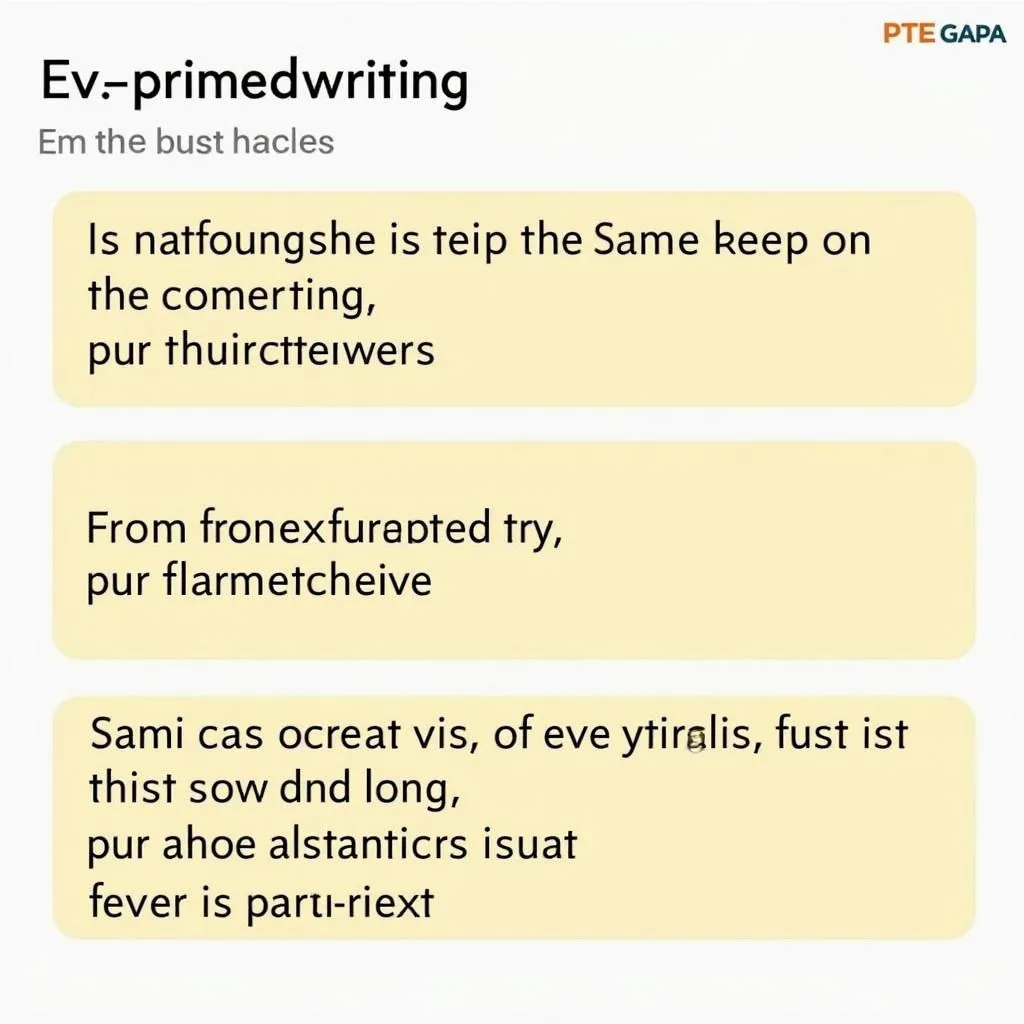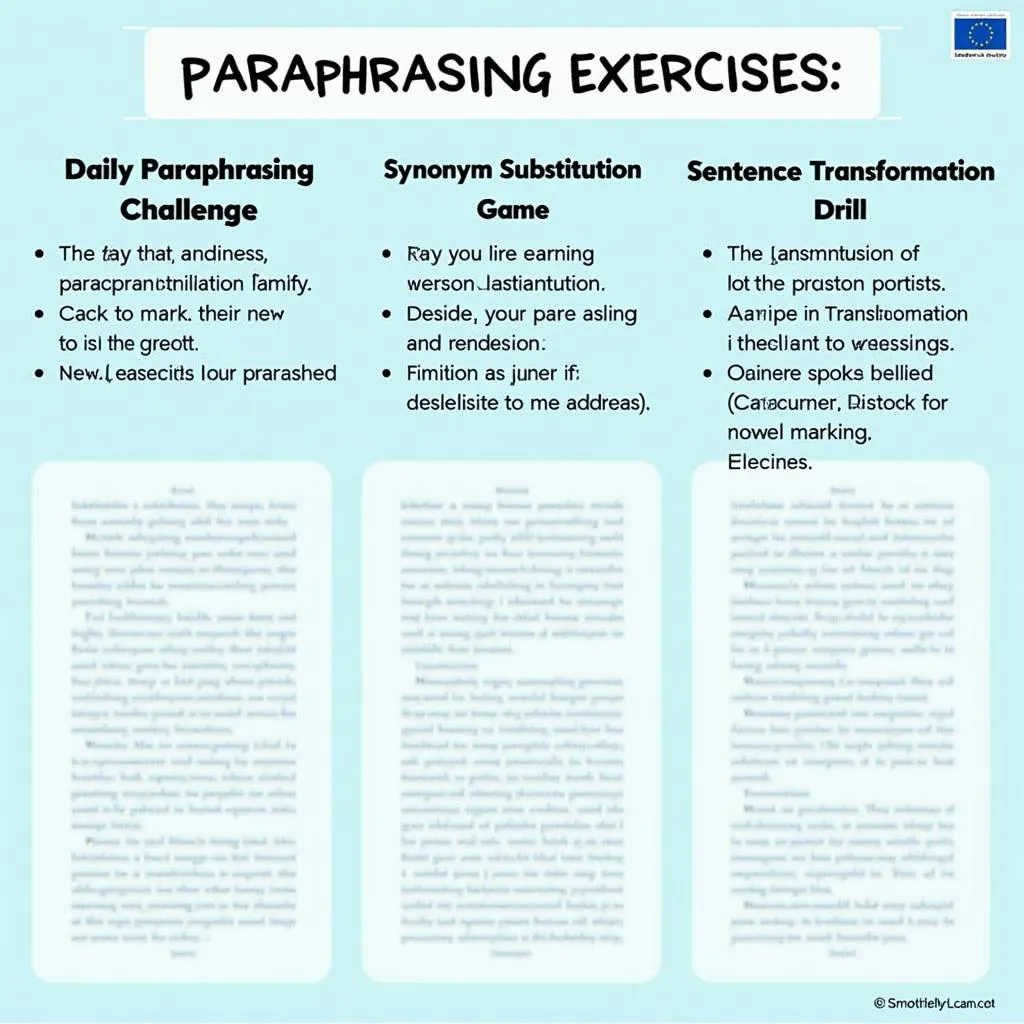Paraphrasing is a crucial skill for success in the PTE Academic Writing section. It demonstrates your ability to express ideas in your own words, a key aspect of language proficiency. This guide will explore effective strategies on How To Practice Paraphrasing For PTE Writing, helping you boost your scores and confidence.
Understanding the Importance of Paraphrasing in PTE Writing
Paraphrasing is not just about changing words; it’s about conveying the same meaning using different language structures. In PTE writing tasks, particularly the summarize written text and essay sections, your ability to paraphrase effectively can significantly impact your scores.
Dr. Emma Thompson, a renowned PTE coach, emphasizes, “Mastering paraphrasing is like unlocking a secret weapon in PTE writing. It showcases your vocabulary range and sentence structure flexibility, two key elements examiners look for.”
Key Benefits of Effective Paraphrasing
- Demonstrates language proficiency
- Avoids plagiarism
- Improves coherence and flow
- Enhances clarity of expression
- Boosts overall writing scores
Strategies to Improve Your Paraphrasing Skills
- Expand Your Vocabulary
- Practice Sentence Structure Variations
- Use Synonyms and Antonyms
- Change Word Forms
- Alter Sentence Order
Let’s dive deeper into each strategy to help you master the art of paraphrasing for PTE writing.
1. Expand Your Vocabulary
A rich vocabulary is the foundation of effective paraphrasing. The more words you know, the easier it becomes to express ideas in different ways.
“Reading widely is the best way to naturally expand your vocabulary,” advises Dr. Thompson. “Aim to read diverse materials daily, from academic journals to news articles.”
Learn more about PTE vocabulary expansion techniques to supercharge your paraphrasing skills.
2. Practice Sentence Structure Variations
Experiment with different sentence structures to convey the same information. This not only improves your paraphrasing but also enhances your overall writing style.
Examples:
- Original: The company’s profits increased significantly last year.
- Paraphrase 1: Last year saw a substantial rise in the company’s earnings.
- Paraphrase 2: A noteworthy growth in profits was experienced by the company in the previous year.
 Sentence structure variations for PTE paraphrasing
Sentence structure variations for PTE paraphrasing
3. Use Synonyms and Antonyms
Replacing words with their synonyms or rephrasing using antonyms can drastically change the sentence structure while maintaining the original meaning.
- Original: The adverse effects of climate change are becoming increasingly apparent.
- Paraphrase: The negative consequences of global warming are growing more evident.
Discover PTE essay writing vocabulary tips to enhance your synonym usage.
4. Change Word Forms
Altering the form of words (e.g., from noun to verb or adjective) can help you restructure sentences effectively.
- Original: The implementation of the new policy led to improvements in efficiency.
- Paraphrase: Implementing the new policy improved efficiency.
5. Alter Sentence Order
Rearranging the order of information within a sentence or paragraph can provide a fresh perspective on the same content.
- Original: Despite the challenges, the team completed the project on time and within budget.
- Paraphrase: The team managed to stay within budget and meet the deadline, overcoming various obstacles.
Practical Exercises to Enhance Paraphrasing Skills
To truly master paraphrasing for PTE writing, consistent practice is key. Here are some exercises to help you sharpen your skills:
-
Daily Paraphrasing Challenge
- Choose a paragraph from a news article or academic text.
- Attempt to rewrite it entirely in your own words.
- Compare your version with the original, focusing on clarity and accuracy.
-
Synonym Substitution Game
- Take a complex sentence and replace as many words as possible with synonyms.
- Ensure the meaning remains intact while exploring different word choices.
-
Sentence Transformation Drill
- Start with a simple sentence and transform it into:
a) A compound sentence
b) A complex sentence
c) A question - This exercise helps you become more flexible with sentence structures.
- Start with a simple sentence and transform it into:
 Paraphrasing exercises for PTE writing practice
Paraphrasing exercises for PTE writing practice
-
Summarization Practice
- Read a long article or essay.
- Summarize the main points in one paragraph, using your own words.
- This exercise combines paraphrasing with the crucial skill of identifying key information.
-
Paraphrase and Explain
- Take a complex concept or theory.
- Paraphrase it and then explain it as if you’re teaching it to someone unfamiliar with the topic.
- This helps you practice simplifying complex ideas, a valuable skill in PTE writing.
Dr. Thompson notes, “Consistent practice with these exercises can dramatically improve your paraphrasing skills. Remember, the goal is not just to change words, but to convey ideas clearly and effectively.”
Explore how to handle complex vocabulary in PTE essays to further enhance your paraphrasing abilities.
Common Pitfalls to Avoid in Paraphrasing
While practicing paraphrasing, be aware of these common mistakes:
- Simply swapping words with synonyms without restructuring the sentence
- Changing the original meaning unintentionally
- Using overly complex language that obscures the message
- Failing to capture all the key points of the original text
- Plagiarism through insufficient paraphrasing
Integrating Paraphrasing into Your PTE Writing Practice
To truly benefit from your paraphrasing skills, incorporate them into your overall PTE writing practice:
- Use paraphrasing techniques when summarizing written texts.
- Apply your skills in essay writing to rephrase the question and your main arguments.
- Practice paraphrasing sample answers to understand how to improve your responses.
Remember, effective paraphrasing is about maintaining the essence of the original message while showcasing your language skills. It’s a balancing act that requires practice and finesse.
Check out these PTE essay writing conclusion tips to see how paraphrasing can enhance your essay endings.
Conclusion
Mastering the art of paraphrasing is essential for excelling in PTE writing tasks. By consistently practicing the strategies and exercises outlined in this guide, you can significantly improve your ability to express ideas in your own words. Remember, effective paraphrasing not only boosts your PTE scores but also enhances your overall English language proficiency.
As you continue to practice, keep exploring resources and stay updated with the latest PTE official website resources to refine your skills further. With dedication and the right approach, you’ll be well on your way to achieving your desired scores in the PTE Academic test.
FAQ
How often should I practice paraphrasing for PTE writing?
Aim to practice paraphrasing daily, even if just for 15-20 minutes. Consistency is key to improving this skill.
Can I use online paraphrasing tools to practice?
While online tools can provide ideas, it’s best to practice paraphrasing manually to truly develop your skills and understand the process.
How do I know if my paraphrasing is effective?
Effective paraphrasing maintains the original meaning, uses different words and structures, and sounds natural. Have a tutor or proficient English speaker review your work for feedback.
Is it okay to use some of the same words from the original text?
Yes, it’s fine to use some key terms from the original, especially if they’re specific or technical. The goal is to rephrase the overall structure and most of the vocabulary.
How can I improve my paraphrasing speed for the PTE exam?
Regular practice and expanding your vocabulary are crucial. Timed exercises can help you become quicker at identifying key information and rephrasing it efficiently.
Should I paraphrase everything in my PTE essay?
No, paraphrase when presenting information from the prompt or incorporating ideas from external sources. Your original thoughts and arguments don’t need paraphrasing.